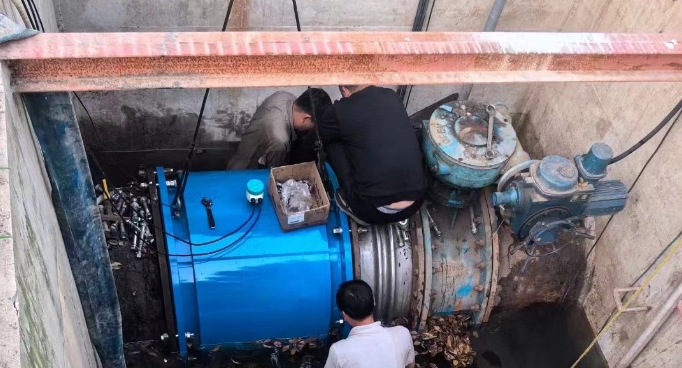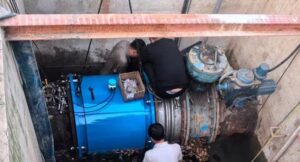The working condition as below
Let’s start by laying out the key working conditions of the electromagnetic flow meter deployed in this project:
- Pipe Diameter: φ200 mm
- Maximum Flow Rate: 80 m³/h
- Minimum Flow Rate: 10 m³/h
- Working Pressure: 10 bar
- Working Temperature: Normal temperature
These parameters define the operational environment—crucial for understanding how the flow meter performs and ensuring accurate measurements across the entire flow range.
Step 1: Measuring Flow Rate and Total Flow — The First Test
Our initial step was to verify whether the flow meter could accurately measure flow rate and total flow. To do this, we employed a simple yet effective approach: collect water in a large tank and weigh it to find out the actual volume passing through.
The process:
- Water flows through the pipe and exits into the tank.
- After 5 minutes, we carefully weigh the water in the tank, which weighs 4.17 tons.
- Simultaneously, the flow meter’s total flow reading indicates 4.23 tons.
What does this tell us?
The slight difference—about 0.06 tons—is well within acceptable measurement error margins, especially given the complexities of flow measurement. The key takeaway? The flow meter’s accuracy in this scenario is much better than 2.5%. That’s a significant validation, confirming its reliability in real-world conditions.
Step 2: Validating the Output Signal Performance
Next, we needed to confirm that the flow meter’s electrical outputs could communicate seamlessly with automation systems. We tested three main signal types:
- 4-20mA analog output
- Pulse output
- RS485 digital communication
Using a PLC (Programmable Logic Controller), we connected each output to monitor their performance.
Results:
- The 4-20mA signal responded linearly and remained stable at different flow rates.
- The pulse output was consistent, accurately reflecting flow changes over time.
- The RS485 interface provided stable, error-free digital data transfer.
In summary: The output signals performed excellently under these conditions. They are compatible with standard industrial automation systems, which is critical for integrating the flow meter into larger control networks.
Step 3: Reverse Flow Testing — Ensuring Bidirectional Accuracy
An essential feature for flow meters used in complex piping networks is their ability to measure reverse flow accurately. We set out to test this capability thoroughly.
The test:
- We induced reverse flow in the pipe, with water flowing back into the system.
- Using the same tank method, we measured the reverse flow rate and total reverse flow.
The results:
- The performance was outstanding, with accuracy far better than 2.5%.
- The flow meter correctly recorded reverse flow volumes, confirming its robustness and precision in bidirectional measurement.
This is especially important in real-world applications where reverse flow can occur due to system fluctuations or operational changes.
Additional Validation: Consistency and Reliability
Throughout the testing phases, the flow meter demonstrated consistent performance—from flow rate accuracy to signal stability and reverse flow measurement. The water tank verification method proved effective and practical in validating the device’s measurement capabilities.
Customer feedback was very positive. They expressed high satisfaction with the performance and reliability of the flow meter. Our engineers also appreciated its stability and ease of integration, confirming that it meets industry standards and client expectations.
Why This Matters — The Significance of Accurate Flow Measurement
In projects like this in Kazakhstan, precise flow measurement is vital for water resource management, industrial process control, and environmental monitoring. The ability of this electromagnetic flow meter to deliver high accuracy, reliable output signals, and robust reverse flow measurement makes it a top choice for such applications.
Furthermore, the performance validation under real working conditions demonstrates its suitability for deployment in challenging environments, such as those involving fluctuating flow rates and bidirectional flows.
Conclusion
To sum up, this project case showcases the excellent performance of the partially filled electromagnetic flow meter in a real-world scenario. Its accuracy surpassing 2.5%, stable output signals, and reliable reverse flow measurement have been proven through rigorous testing.
The customer’s satisfaction, coupled with the engineers’ confidence in the device, confirms that selecting this type of flow meter is a smart decision for complex water management and industrial applications in Kazakhstan and beyond.
This case not only highlights the technical robustness of the electromagnetic flow meter but also underscores the importance of precise, dependable measurement tools in ensuring operational efficiency and resource sustainability.
We are a manufacturer of automatic flow meters with many years of experience in the industry. We have strong independent research and development capabilities and are a leader in the flow meter industry. Our main products include electromagnetic flow meters, vortex flow meters, turbine flow meters, ultrasonic flow meters, Coriolis flow meters, various solenoid valves, level meters, control units and valves, etc. Welcome to purchase –Best Instrument





